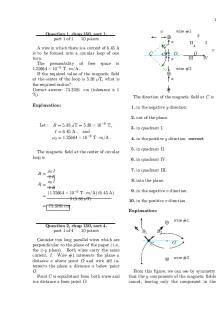Accounting Decision A WK 5 Homework Journal writing PDF

| Title | Accounting Decision A WK 5 Homework Journal writing |
|---|---|
| Course | Marketing Fundamentals |
| Institution | Macquarie University |
| Pages | 1 |
| File Size | 55.9 KB |
| File Type | |
| Total Downloads | 62 |
| Total Views | 148 |
Summary
Download Accounting Decision A WK 5 Homework Journal writing PDF
Description
ACCOUNTING DECISION A WK 5 Homework Name: Rachana Bhat (13274030) Identify accrual components in which the paper examines the effect on future cash flows. Briefly discuss the findings regarding the effect of changes in accrual components on future cash flows. The six major accrual components in which the paper examines the effect on future cash flows are: 1. Change in Accounts Receivable. 2. Change in Accounts Payable. 3. Change in Inventory. 4. Depreciation (reduction in the value of an asset overtime) 5. Amortization (Reduce or payoff a debt with regular payments) 6. Other accruals The report findings show that disaggregating earnings into cash flow and the major components of accruals does enhance the earnings predictability a lot more, which can help the investors and shareholders know the financial positioning of the company. Each accrual component has a different relation with future cash flows. 1. Increase in accounts receivable (AR): When the prediction was positive the coefficient column showed a value of 0.42 which confirms that when there is an increase in accounts receivable there is also an increase in future cash flow. This tells us that company’s finance will increase as remaining payments from customers will be paid which will increase assets and revenue accounts 2. Increase in inventory (INV): When the prediction was positive the coefficient column showed a value of 0.35 which means that increase in inventory also is an increase in future cash flow. This tells us that increase in inventory will keep the company’s distribution flow stable and undisruptive. 3. Decrease in accounts payable (AP): When the prediction was negative as shown in table 13 the coefficient column shows a value of -0.56 which means that reduction in accounts payable also reduces future cash flow. This shows that company having less debt to be payed will put less pressure on expenses/ money going out of the company. 4. Depreciation of fixed assets (DEPR): When the prediction was positive the coefficient column showed a value of 0.42 which means that increase in regular depreciation of fixed assets also brings an increase in future cash flow as timely depreciation keeps the cash flow statement stable and the company knows the exact worth of their assets in current time or future. 5. Amortization of intangible assets (AMORT): When the prediction was positive the coefficient column showed a value of 0.47 which means that increase in amortization also is an increase in future cash flow. This tells us that company paying regular payments timely to complete their debt will not put a pressure on their finances and will give them a stability in their income statement. The Research also showed that cash flow and the major accrual components of earnings had different multiples when predicting future cash flows, as predicted by a model of the accrual process as shown above. The understanding gained from the model is that expected future cash flow can be expressed as a function of several protected of aggregate earnings or as a function of the cash flow and major accrual components of current earnings. And predicting of cash flow showed that using accrual accounting method with the various accrual components of earnings helped capture different information and they were about delayed cash flows related to past transactions, expected future cash flows related to past transactions, future cash flows related to managements expected future operating and investing activity. This showed that accrual components can be highly useful for future cash flow prediction....
Similar Free PDFs

Chapter 5 Accounting homework
- 4 Pages

Task 1b Writing Journal
- 2 Pages

Accounting for Decision Making
- 17 Pages

Sentences homework - Writing
- 1 Pages

Wk5Assgn - wk 5 assignment
- 5 Pages

Decision Theory - Chapter 5
- 97 Pages

Homework 5
- 2 Pages

Homework 5
- 9 Pages

Managerial accounting homework
- 1 Pages

5 Ethical Decision Making
- 6 Pages
Popular Institutions
- Tinajero National High School - Annex
- Politeknik Caltex Riau
- Yokohama City University
- SGT University
- University of Al-Qadisiyah
- Divine Word College of Vigan
- Techniek College Rotterdam
- Universidade de Santiago
- Universiti Teknologi MARA Cawangan Johor Kampus Pasir Gudang
- Poltekkes Kemenkes Yogyakarta
- Baguio City National High School
- Colegio san marcos
- preparatoria uno
- Centro de Bachillerato Tecnológico Industrial y de Servicios No. 107
- Dalian Maritime University
- Quang Trung Secondary School
- Colegio Tecnológico en Informática
- Corporación Regional de Educación Superior
- Grupo CEDVA
- Dar Al Uloom University
- Centro de Estudios Preuniversitarios de la Universidad Nacional de Ingeniería
- 上智大学
- Aakash International School, Nuna Majara
- San Felipe Neri Catholic School
- Kang Chiao International School - New Taipei City
- Misamis Occidental National High School
- Institución Educativa Escuela Normal Juan Ladrilleros
- Kolehiyo ng Pantukan
- Batanes State College
- Instituto Continental
- Sekolah Menengah Kejuruan Kesehatan Kaltara (Tarakan)
- Colegio de La Inmaculada Concepcion - Cebu





